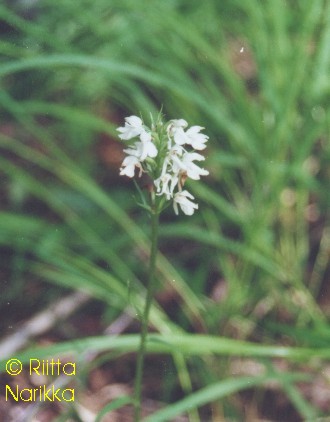
 Dactylorhiza,
liuskakämmekät
Dactylorhiza,
liuskakämmekät
The plant in the right is an example of the difficulty of this genus. It
is easy to find plants , which are not that easy to determine th at
which species it is. This specimen ccould possibly be D. maculata,
as there are lot of those plants around this white specimen. But the flowers
look more like ones of D. fuchsii, and the place would suite better
for that species. White colour of flowers makes it even more difficult
to determine that which species this could be.
at
which species it is. This specimen ccould possibly be D. maculata,
as there are lot of those plants around this white specimen. But the flowers
look more like ones of D. fuchsii, and the place would suite better
for that species. White colour of flowers makes it even more difficult
to determine that which species this could be.
Dactylorhiza is one of the greatest genus of orchids in Europe. In Finland it is clearly the largest genus, with almost 10 species, perhaps even more. Besides the species mentioned, there could also grow D. praetermissa in Finland, and the relationships in D. incarnata- and D. maculata-groups are not too well known. Few species can be found from Asia and one spcies is natural in America, where also D. maculata has spread with Man.
Species D. viridis has here been placed to its own genus Coeloglossum, as it has previously been done.
Almost all Dactylorhizas have red flowers, and the lip is always marked with different reds. White specimens can be found guite often.
 Most
of the Finnish species grows in marshes, only D. sambucina and D.
fuchsii are exceptions. Other species can also be found from varying
places. D. sphagnicola and D. maculata are thought to like
acid soil, but in Finland D. maculata often seems to be at its best
in lime places, it can be found with Cypripediums or Dactylorhiza
incarnatas, and it is actually the plant, which should be looked for
when trying to find good orchid.area in Finland. Other Dactylorhizas
need lime.
Most
of the Finnish species grows in marshes, only D. sambucina and D.
fuchsii are exceptions. Other species can also be found from varying
places. D. sphagnicola and D. maculata are thought to like
acid soil, but in Finland D. maculata often seems to be at its best
in lime places, it can be found with Cypripediums or Dactylorhiza
incarnatas, and it is actually the plant, which should be looked for
when trying to find good orchid.area in Finland. Other Dactylorhizas
need lime.
The genus has bee previously places in genus Orchis. These twogenus are easiest to tell apart by the undergound parts - Dactylorhiza has divided tubers, resembling hand (Finnish name for our wild orchids is "kämmekkä" it comes from genus Dactylorhiza, because kämmen = hand), and in Orchis they are whole.
Read species descriptions for more information about the
systematics in the genus.
1: sambucina - seljakämmekkä
2: sphagnicola- luhtakämmekkä
3: traunsteineri- kaitakämmekkä
4: incarnata - punakämmekkä
5: cruenta - verikämmekkä
6: baltica - leveälehtikämmekkä
7: lapponica - lapinkämmekkä
8: maculata - maariankämmekkä
9: fuchsii - kalkkimaariankämmekkä
10: Dactylorhiza-hybrids